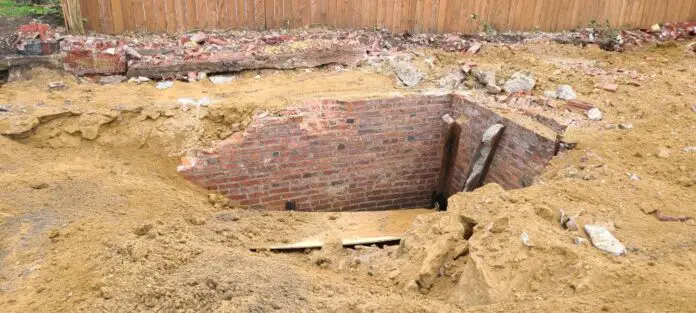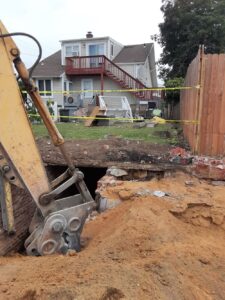Whether it is a tunnel leading to an underground still dating to Prohibition, or tunnels for bootleggers to move illegal whiskey to or from boats that were dealing with rum runners along Rum Row, or whether it was the cellar of a former school what was unearthed on Avenue C. might be a piece of history yesterday afternoon certainly brought neighbors together, lots of excitement to be shared, and historians, Historical society members and borough officials and employees to ensure that no matter what, it was well worth attention.
Word spread quickly throughout the late afternoon when the excavating company clearing and preparing the former Firemen’s Fieldhouse site for construction of three houses on the empty lot dug into what appears to be a tunnel on the northeast side of the property stretching into the backyard of West Highland Avenue house that backs up to the fieldhouse site.
Initial reactions and indications, coupled with legends and stories from generations, were the excavators hit on one of many tunnels reported to be in numerous locations throughout the borough, part of the Prohibition era from 1920 to 1934.
Oldtimers or second and third generation of families living in the borough during that era remember talk of tunnels for transporting illicit alcohol, either to the site from clamming and lobster boats that traveled out to Rum Row three miles offshore to pick it up, or trucks who clandestinely carried the illegal whiskey from its underground hiding places to both local and northern New Jersey liquor dealers, speakeasies and businesses that profited from the law that banned the sale and manufacture of alcohol.
Stories circulated among the gathering of nearby neighbors, friends and officials that tunnels were prevalent in prohibition and this particular tunnel could well be one that led to the Robert Mantell house on Avenue D, once the home of Andrew Richard, a local phenomenon often associated with the rough and wild times of Prohibition.
Talk even circulated that Richards had a friend, Dominick Caruso, well known for his expertise in construction, actually built the tunnel. However, a quick call to Caruso’s daughter, Jacqui Larsen, a retired architect, indicated that was not so.
Born long after Prohibition ended in 1934, Larsen said she heard many stories both from her father and her mother and aunts, all who were neighbors of Richards, as she was growing up. But she never heard her father talk about building any tunnels or underground rooms.
Fire Department secretary Lance Hubeny, recalled how the floor on that side of the fieldhouse, with a garage door opening to Avenue C., was always lower than the rest of the building, and volunteers often wondered and warned about parking heavy equipment on that portion of the building
Atlantic Highlands Historical Society members weren’t asserting specifically what the underground open space was originally but wanted it to be preserved at least until studies could be done, research completed, and a piece of Atlantic Highlands history preserved at least on video and in word. Several Society members turned out to show their interest and learn as much as they could so they could continue research and present an accurate portrayal if what appears to be what families have talked about for ages but will remain hidden as the borough progresses.
Society members on the site gathering whatever information they could were Patty Bickauskas, Ellen O’Dwyer and Lou Fligor. Historians on site were Greg Caggiano, Jack Grodeska and Muriel Smith. In a strange coincidence, Smith is scheduled to give a talk to the Highlands Historical Society at the Community Center in Highlands at 7 p.m. Thursday night on the subject of Prohibition in the Bayshore.
Councilman Brian Dougherty cycled over to see the uncovered tunnel sharing in the excitement and wonder, noting no one really knows yet what it was used for, but sharing in the camaraderie and stories. “It is very exciting, even if we don’t know yet what that tunnel was used for, “he said, adding “I would just encourage people to remember that this is an active construction site on private property. Safety first! “he said, urging people, politely, to stay away from the site.
Code Enforcement Officer Richard Colangelo was also present to ensure safety at the site and to direct anyone walking or standing on the private property of trespassing regulation site.
Borough Police responded to the site to ensure safety, to inspect and ensure no one was inside the tunnel and to cordon off the area with yellow ribbon as a reminder of no trespassing.
The possibility of the tunnel, with supporting beams inside and brick walls, as well as what appears to be a ventilation tube, might also be the cellar of a school, the Washington Avenue School, from the turn of the 20th century. Such a building is portrayed in the Arcadia book on Atlantic Highlands written by Randy Gabrielan.





